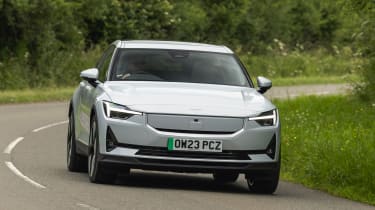Polestar 2 review – ride and handling
A new rear-wheel drive option brings more rewarding, adjustable handling, but the brittle ride can be wearing
Drop into the Polestar 2 and the high scuttle and shallow windows make the cabin feel instantly enveloping, something very different from the open-air feeling of the Model 3. Like Teslas, Polestar has done away with any form of starter button, instead it’s as simple as stepping in and knocking the gear selector back (twice) into D and you’re off. There’s not even an electric handbrake, instead it automatically engages when you reselect P.
Despite Polestar's self-proclaimed positioning as a driver-focused manufacturer, there isn't much to engage you at normal speeds. The steering feels light and lacks the crispness of a BMW i4's (even if neither are especially communicative), the ride feels busy and brittle and the raised driving position isn't especially purposeful. Refinement is good but the Polestar doesn't have the tightly insulated feel of the aforementioned BMW, which truth be told, makes a more convincing first impression.
Things improve when you carry a bit more pace, though, and the 2 makes good on some of Polestar's dynamic promises. The dampers find more breadth as the speed piles on to bring a more compliant, composed feel, and because it doesn't have an artificially quick steering rack to imbue a sense of agility, you can place the Polestar with easy, fluid inputs. This is a good thing, since even the rear-wheel drive Long Range model weighs over two tons and can feel a touch wayward through quick direction changes.
Striking a road imperfection mid-corner can occasionally upset the Polestar's composure as it thuds through the full stroke of the dampers, but there is talent to be enjoyed on decently surfaced roads. Switch to the more lenient ESC Sport mode and there's a tangible sense of the car being pushed from the rear in the single-motor version, and with more commitment this opens up a satisfying window of adjustability. The Polestar's attitude can be tweaked with small flexes of your right foot and it feels neutral and balanced in this state – even if the tall driving position and lifeless steering stop it short of being truly rewarding.
While the rear-drive variant has hot hatch speed, the brakes are adequate and nothing more. The pedal is at least relatively firm and consistent, but there's an overbearing sense of mass when stopping from high speed, and the Polestar feels more comfortable being driven at a swift, more manageable pace. We just wish the suspension was allowed to breath a bit more to suit this driving style, because the stiff-limbed ride often disrupts the flow – we're yet to try the facelifted, Öhlins-equipped Performance Pack model, which could turn this around.




